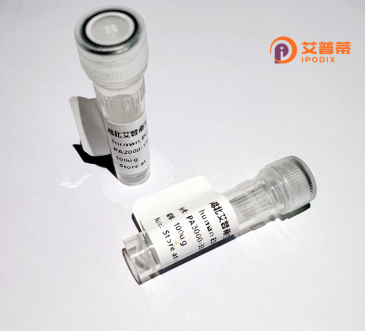
| 纯度 | >90%SDS-PAGE. |
| 种属 | Human |
| 靶点 | TMEM16F |
| Uniprot No | Q4KMQ2 |
| 内毒素 | < 0.01EU/μg |
| 表达宿主 | E.coli |
| 表达区间 | 1-910 aa |
| 活性数据 | MKKMSRNVLLQMEEEEDDDDGDIVLENLGQTIVPDLGSLESQHDFRTPEFEEFNGKPDSLFFNDGQRRIDFVLVYEDESRKETNKKGTNEKQRRKRQAYESNLICHGLQLEATRSVLDDKLVFVKVHAPWEVLCTYAEIMHIKLPLKPNDLKNRSSAFGTLNWFTKVLSVDESIIKPEQEFFTAPFEKNRMNDFYIVDRDAFFNPATRSRIVYFILSRVKYQVINNVSKFGINRLVNSGIYKAAFPLHDCKFRRQSEDPSCPNERYLLYREWAHPRSIYKKQPLDLIRKYYGEKIGIYFAWLGYYTQMLLLAAVVGVACFLYGYLNQDNCTWSKEVCHPDIGGKIIMCPQCDRLCPFWKLNITCESSKKLCIFDSFGTLVFAVFMGVWVTLFLEFWKRRQAELEYEWDTVELQQEEQARPEYEARCTHVVINEITQEEERIPFTAWGKCIRITLCASAVFFWILLIIASVIGIIVYRLSVFIVFSAKLPKNINGTDPIQKYLTPQTATSITASIISFIIIMILNTIYEKVAIMITNFELPRTQTDYENSLTMKMFLFQFVNYYSSCFYIAFFKGKFVGYPGDPVYWLGKYRNEECDPGGCLLELTTQLTIIMGGKAIWNNIQEVLLPWIMNLIGRFHRVSGSEKITPRWEQDYHLQPMGKLGLFYEYLEMIIQFGFVTLFVASFPLAPLLALVNNILEIRVDAWKLTTQFRRLVPEKAQDIGAWQPIMQGIAILAVVTNAMIIAFTSDMIPRLVYYWSFSVPPYGDHTSYTMEGYINNTLSIFKVADFKNKSKGNPYSDLGNHTTCRYRDFRYPPGHPQEYKHNIYYWHVIAAKLALIIVMEHVIYSVKFFISYAIPDVSKRTKSKIQREKYLTQKLLHENHLKDMTKNMGVIAERMIEAVDNNLRPKSE |
| 分子量 | 132.5 kDa |
| 蛋白标签 | GST-tag at N-terminal |
| 缓冲液 | PBS, pH7.4, containing 0.01% SKL, 1mM DTT, 5% Trehalose and Proclin300. |
| 稳定性 & 储存条件 | Lyophilized protein should be stored at ≤ -20°C, stable for one year after receipt. Reconstituted protein solution can be stored at 2-8°C for 2-7 days. Aliquots of reconstituted samples are stable at ≤ -20°C for 3 months. |
| 复溶 | Always centrifuge tubes before opening.Do not mix by vortex or pipetting. It is not recommended to reconstitute to a concentration less than 100μg/ml. Dissolve the lyophilized protein in distilled water. Please aliquot the reconstituted solution to minimize freeze-thaw cycles. |
以下是与重组人TMEM16F蛋白功能相关的3篇代表性文献摘要:
1. **文献名称**:*Calcium-dependent phospholipid scrambling by TMEM16F*
**作者**:Suzuki, J. et al. (2010)
**摘要**:首次确定TMEM16F是一种钙离子依赖性磷脂翻转酶(scramblase),与Scott综合征(凝血障碍)相关,调控细胞膜磷脂酰丝氨酸外翻。
2. **文献名称**:*TMEM16F forms a Ca²⁺-activated cation channel required for lipid scrambling in platelets*
**作者**:Yang, H. et al. (2012)
**摘要**:揭示TMEM16F具有双重功能——钙激活的非选择性离子通道和脂质scramblase,并阐明其突变导致血小板凝血功能障碍的机制。
3. **文献名称**:*Cryo-EM structure of TMEM16F reveals a novel transmembrane channel for lipid scrambling*
**作者**:Alvadia, C. et al. (2019)
**摘要**:通过冷冻电镜解析TMEM16F的三维结构,提出其通过亲水性跨膜凹槽介导脂质翻转的分子机制。
如需扩展,可补充研究病理生理作用的文献:
4. **文献名称**:*TMEM16F-mediated platelet membrane phospholipid scrambling is critical for hemostasis*
**作者**:Fujii, T. et al. (2015)
**摘要**:证明TMEM16F在小鼠血小板中调控凝血关键过程,基因敲除导致严重出血表型。
TMEM16F, a member of the transmembrane protein 16 (TMEM16) family, is a calcium-activated ion channel and phospholipid scramblase critical for maintaining cellular membrane asymmetry. Discovered in 2010. it plays dual roles: facilitating ion transport (e.g., chloride) and scrambling phospholipids between membrane leaflets. This activity is essential for processes like blood coagulation, apoptosis, and cell-cell signaling. Structurally, it forms a dimer with each subunit containing 10 transmembrane domains and a hydrophilic groove for lipid scrambling.
TMEM16F is widely expressed in platelets, immune cells, and epithelial tissues. Its dysfunction links to Scott syndrome, a rare bleeding disorder caused by impaired phosphatidylserine exposure, crucial for clotting. Additionally, TMEM16F mediates extracellular vesicle release (e.g., microparticles in inflammation) and impacts viral entry (e.g., SARS-CoV-2). Recent studies highlight its role in neurodegenerative diseases, cancer metastasis, and osteogenesis, though mechanistic details remain debated.
As a therapeutic target, TMEM16F modulation holds potential for treating thrombosis, immune disorders, and neurological conditions. However, challenges persist in distinguishing its ion channel vs. scramblase functions and identifying selective inhibitors. Ongoing research aims to unravel its regulation by calcium, membrane tension, and lipid composition, offering insights into membrane dynamics and disease pathogenesis.
×